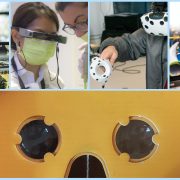My first introduction to virtual reality was the horribly dated 1992 film The Lawnmower Man, a cheesy hybrid of a Stephen King short story and George Bernard Shaw’s Pygmalion. The movie itself is a beautiful mess, a delightful snack depicting the evils of a virtual world. The ten-year-old me was in awe, this was real, this would be in our living rooms within a few years, virtual reality had arrived!
But, decades of overpriced headache inducing consoles, headsets, glasses and 3D experiences have rendered the technology, at least in popular culture, to nothing short of a fad.
Then we had 2020, the year of COVID, lockdowns, burdensome Zoom calls and an impressive array of augmented reality trends reaching the common market. If you haven’t played with an avatar on a conference platform this year, well, then you’re in the minority.
VR/AR development has shifted significantly from gaming and entertainment, instead moving towards a measurable, customisable and high-adaptive channel for business. From virtual meetings, through to team-building and, most importantly, measurable and safe training, within the next three to five years, this technology will become standard.
What does this mean for industry though? How will VR benefit your business by improving training standards, providing complete worker safety, ensure better product design and ultimately save you money?
Here are some examples of VR/AR technology already in the market that you can expect to see more of
- Workplace training
VR/AR is low-cost, highly effective training tool which allows for detail analysis of complex tasks. Think of it as critical as a flight simulator, with the ability to monitor every movement, action and procedure in real-time. High-risk, dangerous and expensive training can be performed within a low-risk environment at a fraction of the financial and potential human cost.
- Customer Engagement
Many of us may have already used AR applications when looking at buying a new car or being creative with the myriad paint tones available to make your feature wall “pop”. But consider the roll-out of 5G networks, improved handsets, and an increasingly competitive retail market, and soon we will engaging with brands in a far more gamified and immersive way.
- Conferences, classes and events.
As mentioned before, many of us have already experienced a “virtual event” with the capability of moving an avatar from room to room, engaging with other live people in a virtual space. Even as events return to a live model, increasingly we will find hybrid events becoming commonplace, no longer necessitating the need to travel to a venue, pay for flights and accommodation, and sitting through hours of irrelevant content. Similarly, online education is set to increase (invest in EdTech now), with virtual interactive classrooms touted as the future of learning.
- Internal education and field assistance
Imagine your “intranet” being a virtualised space. Every product categorised and accessible in 3D on a digital ecosystem, allowing employees to not only train and develop their skills within their particular niche, but also interact with partners across the organisation. The benefit of VR/AR is how explicit and intricate the information can be. Imagine a field worker being able to bring up a 3D model of a particular device, run a diagnostics test and be sent the results within real-time. Not only can we improve on the job training, but also empower employees to act independently, efficiently and with zero room for error.
- Construction and engineering design
VR enables 3D modelling which places the user directly inside the built environment, enabling various project stakeholders (especially financiers) to experience a building before even breaking ground. Not only will this technology help improve design, enhance project coordination and collaboration, but ultimately it will mitigate reworking costs, frustrated clients, and the usual curveballs associated with regards to permits and health and safety. And when it comes to full scale engineering, the possibilities are endless – constructing a virtual functioning design without the massive rolling costs of physical development.
We want to engage you at Hello Innovation. As a community builder, our aim is to share knowledge from numerous innovators from the most cutting-edge software designers through to the business mavericks driving digital change. This is but an introduction to Hello Innovation, so do get in touch to see how you too can contribute to these discussions. Contact me directly at ryan.matthews@helloinnovation.co.za

Ryan J. Matthews | Editor-in-Chief
Hello Innovation

